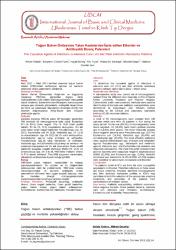| dc.contributor.author | Yüksek, Adnan | |
| dc.contributor.author | Turan, Bünyamin Cüneyt | |
| dc.contributor.author | Güneş, Hayati | |
| dc.contributor.author | Turan, Filiz | |
| dc.contributor.author | Sarıkaya, Hatice Gül | |
| dc.contributor.author | Doğan, Mustafa | |
| dc.contributor.author | Arar, Makbule Cavidan | |
| dc.date.accessioned | 2017-07-31T08:31:02Z | |
| dc.date.available | 2017-07-31T08:31:02Z | |
| dc.date.issued | 2013 | |
| dc.identifier.uri | https://hdl.handle.net/20.500.11776/2173 | |
| dc.description.abstract | Amaç Mart 2012 – Mart 2013 tarihleri arasında yoğun bakım ünitesi (YBÜ)’ndeki enfeksiyon ajanları ve bunların antibiyotik direnç paternlerini belirlemek. Materyal ve Metod Namık Kemal Üniversitesi Araştırma ve Uygulama Hastanesi YBÜ’den gönderilen değişik klinik materyallerden izole edilen mikroorganizmalar retrospektif olarak incelendi. Bakterilerin identifikasyonu konvansiyonel ve/veya yarı otomatik yöntemlerle, antibiyotik duyarlılıkları da Klinik ve Laboratuar Standartları Enstitüsü (CLSI)’nün önerileri doğrultusunda Kirby-Bauer disk difüzyon yöntemiyle yapıldı. Bulgular Çalışma boyunca YBÜ’de yatan 26 hastadan gönderilen 185 örnekten 59 mikroorganizma izole edildi. Bunlardan 41’i (% 69,5) Gram negatif, 10’u (% 16,9) Gram pozitif bakteri, 8’i de (% 13,5) mayalardan oluşuyordu. En sık izole edilen Gram negatif bakteriler Pseudomonas spp. (% 23,7), Escherichia coli (% 16,9), Klebsiella spp. (% 11,9) ve Acinetobacter spp. (% 10,2) idi. En etkili antibiyotikler; Acinetobacter spp.’ye karşı amikasin ve seftazidim, Pseudomonas spp.’ye karşı tobramisin ve netilmisin, Klebsiella spp. ve Escherichia coli’ye karşı da amikasin ve imipenem-meropenem idi. En sık izole edilen Gram pozitif bakteriler koagülaz negatif stafilokok (KNS) (% 13,5) ve Enterococcus spp. (% 3,4) idi. KNS’lerde metisilin direnci % 71,4 olarak belirlendi. Tüm KNS suşlarının vankomisin, teikoplanin ve linezolide duyarlı olduğu görüldü. Sonuç YBÜ’lerde yatan hatsalar, hastanedeki en hassas populasyonlardandır. Bu yüzden de bu bölgelerdeki enfeksiyonlar ciddi bir problemlerdir. YBÜ’lerde üremiş mikroorganizmalar ve bunların antibiyotik direnç paternlerinin bilinmesi; hem uygun ampirik tedaviye, hem de hastaları dirençli mikroorganizmalarla kontaminasyondan korumaya yardımcı olabilir. | en_US |
| dc.description.abstract | Aim To determine the causative agents of infections in intensive care unit (ICU) and their antibiotic resistance patterns between dates March 2012 – March 2013. Materials and Methods A retrospective study was carried out of microorganisms isolated from the different clinic materials in ICU of Namik Kemal University Research and Practice Hospital. Conventional and/or semiautomatic methods were used for identification of bacteria and antibiotic susceptibilities were determined by Kirby-Bauer disk diffusion method according to the Clinical and Laboratory Standards Institute (CLSI) recommendations. Results A total of 59 microorganisms were isolated from 185 samples which sent from 26 patients in ICU during the study period. Fourty-one (69,5%) of microorganisms were Gram negative, 10 (16,9%) were Gram positive bacteria and 8 (13,5%) were yeasts. The most frequently isolated Gram negative bacteria were Pseudomonas spp. (23,7%), Escherichia coli (16,9%), Klebsiella spp. (11,9%) and Acinetobacter spp. (10,2%). The most effective antibiotics were; against Acinetobacter spp. amikacin and ceftazidim, against Pseudomonas spp. tobramycin and netilmicin, against Klebsiella spp. and Escherichia coli amikacin and imipenem-meropenem. The most frequently isolated Gram positive bacteria were coagulase negative staphylococcus (CNS) (13,5%), and Enterococcus spp. (3,4%). Meticillin resistance was detected in 71,4% of CNS. All CNS isolates were sensitive to vancomycin, teicoplanin and linezolid. Conclusion The patients found in ICU are from the most susceptible populations in hospital. Therefore infections in these areas are major problems. Knowing identified microorganisms and their antibiotic resistance profiles in ICU’s may contribute to both the selection of the appropriate empirical treatments and protection of the patients from contamination of resistant strains. | en_US |
| dc.language.iso | tur | en_US |
| dc.publisher | Namık Kemal Üniversitesi, Tıp Fakültesi | en_US |
| dc.rights | info:eu-repo/semantics/openAccess | en_US |
| dc.subject | Antibiyotik duyarlılığı | en_US |
| dc.subject | antibiyotik direnci | en_US |
| dc.subject | Gram negatif bakteriler | en_US |
| dc.subject | Gram pozitif bakteriler | en_US |
| dc.subject | yoğun bakım ünitesi | en_US |
| dc.subject | yoğun bakım enfesiyonları | en_US |
| dc.subject | Acinetobacter | en_US |
| dc.subject | Escherichia coli | en_US |
| dc.subject | Klebsiella | en_US |
| dc.subject | Pseudomonas | en_US |
| dc.subject | Antibiotic susceptibility | en_US |
| dc.subject | antibiotic resistance | en_US |
| dc.subject | Gram negative bacteria | en_US |
| dc.subject | Gram positive bacteria | en_US |
| dc.subject | intensive care unit | en_US |
| dc.subject | intensive care infections | en_US |
| dc.title | Yoğun Bakım Ünitesinde Yatan Hastalardan İzole edilen Etkenler ve Antibiyotik Direnç Paternleri | en_US |
| dc.title.alternative | The Causative Agents of Infections in Intensive Care Unit and Their Antibiotic Resistance Patterns | en_US |
| dc.type | article | en_US |
| dc.relation.ispartof | Namık Kemal Tıp Dergisi (International Journal of Basic and Clinical Medicine) | en_US |
| dc.department | Fakülteler, Tıp Fakültesi, Cerrahi Tıp Bilimleri Bölümü | en_US |
| dc.authorid | 145536 | en_US |
| dc.authorid | 145526 | en_US |
| dc.authorid | 109121 | en_US |
| dc.authorid | 160323 | en_US |
| dc.authorid | 134754 | en_US |
| dc.authorid | 187916 | en_US |
| dc.authorid | 103272 | en_US |
| dc.identifier.volume | 1 | en_US |
| dc.identifier.issue | 1 | en_US |
| dc.identifier.startpage | 1 | en_US |
| dc.identifier.endpage | 6 | en_US |
| dc.relation.publicationcategory | Makale - Ulusal Hakemli Dergi - Kurum Öğretim Elemanı | en_US |



















